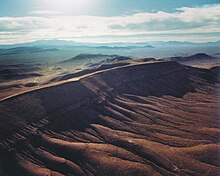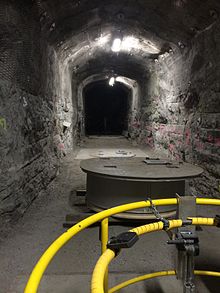
Radioactive waste is a type of hazardous waste that contains radioactive material. Radioactive waste is a result of many activities, including nuclear medicine, nuclear research, nuclear power generation, rare-earth mining, and nuclear weapons reprocessing. The storage and disposal of radioactive waste is regulated by government agencies in order to protect human health and the environment.

The Yucca Mountain Nuclear Waste Repository, as designated by the Nuclear Waste Policy Act amendments of 1987, is a proposed deep geological repository storage facility within Yucca Mountain for spent nuclear fuel and other high-level radioactive waste in the United States. The site is on federal land adjacent to the Nevada Test Site in Nye County, Nevada, about 80 mi (130 km) northwest of the Las Vegas Valley.

Dry cask storage is a method of storing high-level radioactive waste, such as spent nuclear fuel that has already been cooled in the spent fuel pool for at least one year and often as much as ten years. Casks are typically steel cylinders that are either welded or bolted closed. The fuel rods inside are surrounded by inert gas. Ideally, the steel cylinder provides leak-tight containment of the spent fuel. Each cylinder is surrounded by additional steel, concrete, or other material to provide radiation shielding to workers and members of the public.

The Waste Isolation Pilot Plant, or WIPP, is the world's third deep geological repository licensed to store transuranic radioactive waste for 10,000 years. The storage rooms at the WIPP are 2,150 feet underground in a salt formation of the Delaware Basin. The waste is from the research and production of United States nuclear weapons only. The plant started operation in 1999, and the project is estimated to cost $19 billion in total.

Low-level waste (LLW) or Low-level radioactive waste (LLRW) is nuclear waste that does not fit into the categorical definitions for intermediate-level waste (ILW), high-level waste (HLW), spent nuclear fuel (SNF), transuranic waste (TRU), or certain byproduct materials known as 11e(2) wastes, such as uranium mill tailings. In essence, it is a definition by exclusion, and LLW is that category of radioactive wastes that do not fit into the other categories. If LLW is mixed with hazardous wastes as classified by RCRA, then it has a special status as mixed low-level waste (MLLW) and must satisfy treatment, storage, and disposal regulations both as LLW and as hazardous waste. While the bulk of LLW is not highly radioactive, the definition of LLW does not include references to its activity, and some LLW may be quite radioactive, as in the case of radioactive sources used in industry and medicine.

The Nuclear Waste Policy Act of 1982 is a United States federal law which established a comprehensive national program for the safe, permanent disposal of highly radioactive wastes.

A deep geological repository is a way of storing hazardous or radioactive waste within a stable geologic environment. It entails a combination of waste form, waste package, engineered seals and geology that is suited to provide a high level of long-term isolation and containment without future maintenance. This will prevent any radioactive dangers. A number of mercury, cyanide and arsenic waste repositories are operating worldwide including Canada and Germany and a number of radioactive waste storages are under construction with the Onkalo in Finland being the most advanced.

Spent nuclear fuel, occasionally called used nuclear fuel, is nuclear fuel that has been irradiated in a nuclear reactor. It is no longer useful in sustaining a nuclear reaction in an ordinary thermal reactor and depending on its point along the nuclear fuel cycle, it may have considerably different isotopic constituents. The term "fuel" is slightly confusing, as it implies a combustion of some type, which does not occur in a nuclear power plant. Nevertheless, this term is generally accepted.

Nuclear power in the United States is provided by 92 commercial reactors with a net capacity of 94.7 gigawatts (GW), with 61 pressurized water reactors and 31 boiling water reactors. In 2019, they produced a total of 809.41 terawatt-hours of electricity, which accounted for 20% of the nation's total electric energy generation. In 2018, nuclear comprised nearly 50 percent of US emission-free energy generation.
Deep borehole disposal (DBD) is the concept of disposing high-level radioactive waste from nuclear reactors in extremely deep boreholes instead of in more traditional deep geological repositories that are excavated like mines. Deep borehole disposal seeks to place the waste as much as five kilometres (3 mi) beneath the surface of the Earth and relies primarily on the thickness of the natural geological barrier to safely isolate the waste from the biosphere for a very long period of time so that it should not pose a threat to humans and the environment. The concept was originally developed in the 1970s, but in 2014 a proposal for a first experimental borehole was proposed by a consortium headed by Sandia National Laboratories.

Nuclear safety in the United States is governed by federal regulations issued by the Nuclear Regulatory Commission (NRC). The NRC regulates all nuclear plants and materials in the United States except for nuclear plants and materials controlled by the U.S. government, as well those powering naval vessels.
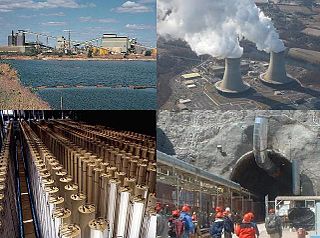
Nuclear power has various environmental impacts, including the construction and operation of the plant, the nuclear fuel cycle, and the effects of nuclear accidents. Nuclear power plants do not burn fossil fuels and so do not directly emit carbon dioxide. The carbon dioxide emitted during mining, enrichment, fabrication and transport of fuel is small when compared with the carbon dioxide emitted by fossil fuels of similar energy yield, however, these plants still produce other environmentally damaging wastes.

High-level radioactive waste management concerns how radioactive materials created during production of nuclear power and nuclear weapons are dealt with. Radioactive waste contains a mixture of short-lived and long-lived nuclides, as well as non-radioactive nuclides. There was reportedly some 47,000 tonnes of high-level nuclear waste stored in the United States in 2002.
In Pacific Gas & Electric Co. v. State Energy Resources Conservation & Development Commission, 461 U.S. 190 (1983), the United States Supreme Court held that a state statute regulating economic aspects of nuclear generating plants was not preempted by the federal Atomic Energy Act of 1954. The case provides a framework that has guided other cases involving preemption of federal authority.

The nuclear energy policy of the United States began in 1954 and continued with the ongoing building of nuclear power plants, the enactment of numerous pieces of legislation such as the Energy Reorganization Act of 1974, and the implementation of countless policies which have guided the Nuclear Regulatory Commission and the Department of Energy in the regulation and growth of nuclear energy companies. This includes, but is not limited to, regulations of nuclear facilities, waste storage, decommissioning of weapons-grade materials, uranium mining, and funding for nuclear companies, along with an increase in power plant building. Both legislation and bureaucratic regulations of nuclear energy in the United States have been shaped by scientific research, private industries' wishes, and public opinion, which has shifted over time and as a result of different nuclear disasters.
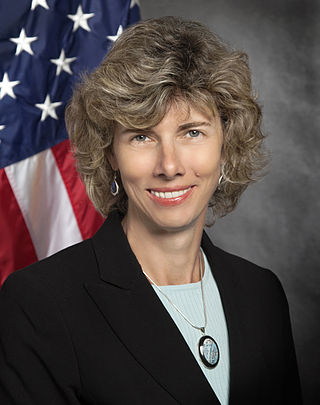
Allison M. Macfarlane directs the School of Public Policy and Global Affairs at the University of British Columbia. She is the former director of the Institute for International Science and Technology Policy at George Washington University, where she was Professor of Science Policy and International Affairs. She was the chairman of the United States Nuclear Regulatory Commission (NRC) from July 9, 2012, to December 31, 2014.
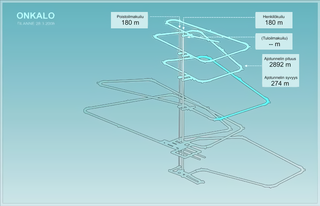
The Onkalo spent nuclear fuel repository is a deep geological repository for the final disposal of spent nuclear fuel. It is near the Olkiluoto Nuclear Power Plant in the municipality of Eurajoki, on the west coast of Finland. It is being constructed by Posiva, and is based on the KBS-3 method of nuclear waste burial developed in Sweden by Svensk Kärnbränslehantering AB (SKB). The facility is expected to be operational in 2023.
The U.S. Nuclear Waste Technical Review Board was established in the 1987 Nuclear Waste Policy Amendments Act (NWPAA) to "...evaluate the technical and scientific validity of activities [related to managing and disposing of spent nuclear fuel and high-level radioactive waste] undertaken by the Secretary [of Energy], including
- site characterization activities; and
- activities relating to the packaging or transportation of high-level radioactive waste or spent nuclear fuel."
The Czech Radioactive Waste Repository Authority (SÚRAO) was established on 1 June 1997 as a state organisation established by the Ministry of Industry and Trade. In 2001, SÚRAO assumed the status of a government agency. The Authority is headed by its managing director, Dr. Jiří Slovák. The governing body of SÚRAO consists of its Board which is made up of representatives from the government, radioactive waste producers and the general public. The managing director and members of the Board of SÚRAO are directly appointed by the Minister of Industry and Trade.

Deep horizontal drillhole disposal is the concept of disposing of high-level radioactive waste from a nuclear reactor in deep horizontal boreholes instead of in more traditional deep geological repositories that are excavated like mines. The design concept is intended to improve upon the vertical borehole concept developed by Sandia National Laboratories, by utilizing modern advancements in directional drilling technology as well as using isotopic methods to measure the affinity a host rock has for isolation.
